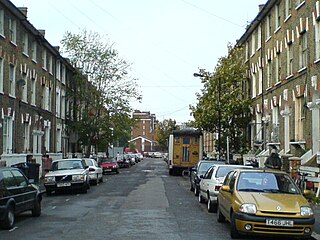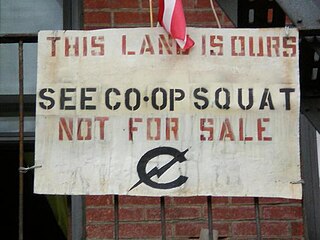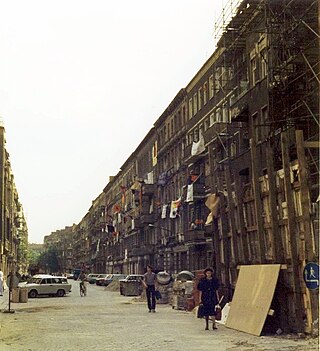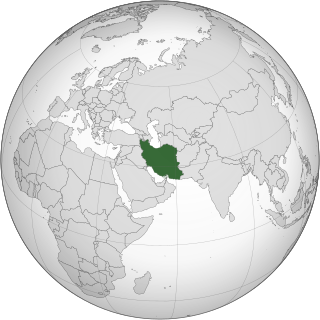Related Research Articles

Squatting is the action of occupying an abandoned or unoccupied area of land or a building, usually residential that the squatter does not own, rent or otherwise have lawful permission to use. The United Nations estimated in 2003 that there were one billion slum residents and squatters globally. Squatting occurs worldwide and tends to occur when people find empty buildings or land to occupy for housing. It has a long history, broken down by country below.

ABC No Rio is a collectively-run nonprofit arts organization on New York City's Lower East Side. Founded in 1980 in a squat at 156 Rivington Street, following the eviction of the 1979–80 Real Estate Show, the center featured an art gallery space, a zine library, a darkroom, a silkscreening studio, and public computer lab. In addition, it played host to a number of radical projects including weekly hardcore punk matinees and the city Food Not Bombs collective. ABC No Rio was directed by Steven Englander from 1998 until his death in 2024.

Villa Amalia is the name of the building that hosted the former Second High School of Athens in Greece. It is located on the corner of Acharnon and Heiden streets, near Victoria metro station. It was an anarchist squat before its eviction in 2012. It reopened as a school in 2016.

St Agnes Place was a squatted street in Kennington, south London, which resisted eviction orders for more than 30 years. When a number of derelict houses were scheduled for demolition to extend Kennington Park in 1969, squatters occupied the properties and a High Court injunction prevented the demolition. The street was run by a housing cooperative until 2005, when Lambeth London Borough Council obtained an eviction order. Demolition was completed in 2007.

London Street Commune was a hippy movement formed during the 1960s. It aimed to highlight concerns about rising levels of homelessness and to house the hundreds of hippies sleeping in parks and derelict buildings in central London.
The Battle of Ryesgade was a nine-day series of street fights in mid-September 1986, in the Copenhagen street Ryesgade. It was the most violent event in a long-standing conflict between the Copenhagen City Council and the city's community of squatters. Faced with an ultimatum to leave their illegally occupied housing or face eviction, the squatters instead fortified the streets around their building so strongly that it became a cop-free zone. They took advantage of this lack of control by burning down a building belonging to the Sperry Corporation. For nine days, massed police unsuccessfully attempted to evict the squatters. The civil disorder was of a magnitude never before seen in Denmark. After communicating a manifesto through the media, the defenders finally abandoned the squat and dispersed without being apprehended.
The Advisory Service for Squatters (A.S.S.) is a non-profit group based in London and run by volunteers. It aims to provide practical advice and legal support for squatters. It was founded in 1975, having grown out of the Family Squatters Advisory Service. After being based for many years in St. Paul's Road in Islington, A.S.S. moved its offices to Whitechapel High Street, in the same building as Freedom Press.

C-Squat is a former squat house located at 155 Avenue C in the Alphabet City neighborhood of Manhattan, New York City that has been home to musicians, artists, and activists, among others. After a fire, it was taken into city ownership in 1978 and squatters moved in 1989. The building was restored in 2002 and since then it has been legally owned by the occupants. Its ground-floor storefront now houses the Museum of Reclaimed Urban Space.
The Frances Street Squats were a set of six squatted houses, including one women-only building, that existed between February and November 1990 in Vancouver, Canada. They were occupied by SAVE and took a stand against development which was generally supported by local people. The Vancouver Police Department evicted the buildings.

In England and Wales, squatting – taking possession of land or an empty house the squatter does not own – is a criminal or civil offence, depending on circumstances. People squat for a variety of reasons which include needing a home, protest, poverty, and recreation. Many squats are residential; some are also opened as social centres. Land may be occupied by New Age travellers or treesitters.
In the United States, squatting occurs when a person enters land that does not belong to them without lawful permission and proceeds to act in the manner of an owner. Historically, squatting occurred during the settlement of the Midwest when colonial European settlers established land rights and during the California Gold Rush. There was squatting during the Great Depression in Hoovervilles and also during World War II. Shanty towns returned to the US after the Great Recession (2007–2009) and in the 2010s, there were increasing numbers of people occupying foreclosed homes using fraudulent documents. In some cases, a squatter may be able to obtain ownership of property through adverse possession.

Kill City: Lower East Side Squatters 1992–2000 is a photography book by Ash Thayer, documenting the squatting scene in New York City's Lower East Side in the 1990s. Kill City was published in 2015 by PowerHouse Books.
CHARAS/El Bohio Community Center was a neighborhood organization and squatted community center in New York's East Village between 1979 and 2001.
Umbrella House is a former squat and a Housing Development Fund Corporation in New York City's East Village, at 21-23 Avenue C. The squat, formed in 1988, was known for its political engagement and high level of collective organization among its members. In 2010, the building officially became a housing cooperative.

Squatting in the Republic of Ireland is the occupation of unused land or derelict buildings without the permission of the owner. In the 1960s, the Dublin Housing Action Committee highlighted the housing crisis by squatting buildings. From the 1990s onwards there have been occasional political squats in Cork and Dublin such as Grangegorman, the Barricade Inn, the Bolt Hostel, Connolly Barracks, That Social Centre and James Connolly House.

Squatting in the Netherlands is the occupation of unused or derelict buildings or land without the permission of the owner. The modern squatters movement began in the 1960s in the Netherlands. By the 1980s, it had become a powerful anarchist social movement which regularly came into conflict with the state, particularly in Amsterdam with the Vondelstraat and coronation riots.
Operation Move-In was a housing and squatter rights movement of the 1970s. The movement consisted of various anti-poverty and community organizations in New York City, including Metropolitan Council on Housing. It was an early example of New York City squatter activism, which strengthened in the 1980s, and helped publicize tenant rights.

The battle of Mainzer Straße took place in Friedrichshain, East Berlin between 12 and 14 November 1990. It was a major incident in the history of the city, following the fall of the Berlin Wall in 1989. The magistrate of East Berlin decided to evict a row of squatted apartment blocks and the autonomous movement resisted the eviction for three days, until the buildings were all evicted by the police. One person was wounded by a ricochet and 417 people were arrested in an operation of over 3,000 officers. Following the riots, the magistrate decided to concentrate on legalizing squats in Berlin.

Squatting in Iran mostly occurs around the major cities, as rural migrants move to urban centres. From the 1950s onwards shanty towns have been set up and inhabitants are known as "koukhnishinan". Following the Iranian Revolution of 1979, squatter settlements increased, with the state sometimes evicting and sometimes legalizing the areas.
The modern political squatting movement began in Hamburg, Germany, when Neue Große Bergstraße 226 was occupied in 1970. Squatters wanted to provide housing for themselves amongst other demands such as preventing buildings from being demolished and finding space for cultural activities. The Hafenstraße buildings were first occupied in 1981 and were finally legalized after a long political struggle in 1995. The still extant Rote Flora self-managed social centre was occupied in 1989. Squatting actions continue into the present; more recent attempts are quickly evicted, although the Gängeviertel buildings were squatted and legalized in the 2010s.
References
- ↑ Pruijt H (2003) Is the institutionalization of urban movements inevitable? A comparison of the opportunities for sustained squatting in New York City and Amsterdam in International Journal of Urban and Regional Research, Vol. 27, nr. 1 Available online
- 1 2 3 Ciezadlo, Annie (September–October 2002). "Squatters' Rites: Taking Liberties – A Brief History of New York City's Squats". City Limits Magazine. Archived from the original on November 21, 2007.
- 1 2 3 4 Leland, John (August 3, 2000). "On Avenue C, Renewal and Regret". The New York Times.
- 1 2 3 Moynihan, Colin (April 4, 1999). "We'll Stay, Squatters Insist". The New York Times.
- ↑ Anderson, Lincoln (November 3–9, 2006). "Downtown anarchist/reporter killed in Mexico". Downtown Express. Archived from the original on 2008-12-02.
- ↑ "ABC NO RIO Survives, Fifth Street Buried Alive Tape #269". Paper Tiger Television. Retrieved 2022-10-03.
- 1 2 3 Cooper, Michael (April 28, 1999). "Police Evict Band of Squatters Barricaded in the East Village". The New York Times.
- ↑ Claffey, Mike; Breen, Virginia (April 28, 1999). "COPS ROUT SQUATTERS IN EAST VILLAGE CLASH". Daily News. New York. Archived from the original on 2011-07-14.